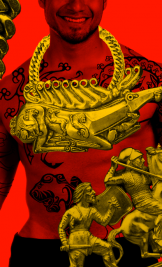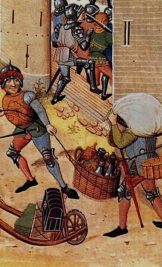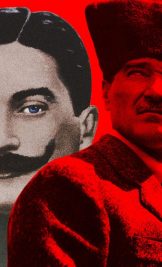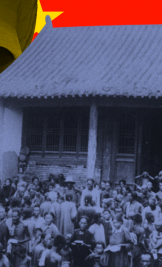

Headhunters: 5 English-style murders
Eddard Stark was executed in the first season of Game of Thrones, but his head adorned the gates of King's Landing for a long time. George Martin, the author of the original novels, did not have to think up the plot long, just to open the history of England.
The Celtic peoples of Britain had a reputation as head hunters. Dismemberment of the enemy’s body was a religious ritual. The ancient Greek historian Diodorus Siculus wrote in the 1st century BC: ‘They cut off the heads of enemies killed in battle and fasten them about the necks of their horses; and turning over to their attendants the arms of their opponents, all covered with blood, they carry them off as booty, singing a paean over them and striking up a song of victory, and these first-fruits of battle they fasten by nails upon their houses, just as men do, in certain kinds of hunting, with the heads of wild beasts they have mastered. The heads of their most distinguished enemies they embalm in cedar-oil and carefully preserve in a chest, and these they exhibit to strangers, gravely maintaining that in exchange for this head some one of their ancestors, or their father, or the man himself, refused the offer of a great sum of money.’

The Tale of Bygone Years tells of the death of Prince Sviatoslav Ihorovych in 972: ‘When spring came, Sviatoslav approached the cataracts, where Kurya, Prince of the Pechenegs, attacked him; and Sviatoslav was killed. The nomads took his head, and made a cup out of his skull, overlaying it with gold, and they drank from it.’
Over time, the cultic meaning of the procedure disappeared. The public display of the head of a hated person became part of psychological warfare, to teach others the lesson.
13th century
Simon de Montfort
In the mid-13th century, King Henry III of England imposed new taxes on the aristocracy to finance the Crusades and wars with neighbors.
Earl Simon de Montfort, the owner of vast lands, governor of Gascony and husband of the king’s sister, did not get along well with his brother-in-law. In 1258, he joined the feudal rebellion and soon led the opposition.
The rebellious barons drafted the Provisions of Oxford, a bill of reforms that would limit the king’s rights and expand the powers of the council, which would later be called parliament.
In 1264, Henry III enlisted the support of the King of France and the Pope to start a civil war. In the very first battle, the king, his brother and son Edward were taken prisoner. Simon de Montfort became Lord Protector of England.
Prince Edward managed to escape. He gathered a 10,000-strong army of royalists to fight against the barons’ half-sized army. On August 4, 1265, the parties meet near the River Avon.
Montfort died. The dead earl was beheaded and his scrotum was hung on his nose. In this form, the head was mounted on a spear and sent as a trophy to the wife of Baron Roger Mortimer, a close associate of Prince Edward. Montfort’s hands and feet were sent to the king’s enemies.

15th century
Richard Plantagenet
The title of Duke of York was so prestigious that from the second half of the 15th century it was given to the second sons of kings. But while the first half of the century was still going on, Richard Plantagenet, Duke of York, enjoyed his power. He was the viceroy of Ireland, commander-in-chief of the English army in France, regent of the young Henry VI and husband of his sister.
Richard was related to the royal family on his mother’s side. He reasonably hoped to take the throne when the physically weak and mentally ill Henry VI would die childless. The plan was thwarted by the queen, the powerful Margaret of Anjou. She gave birth to a son, most likely from a lover, and then deprived Richard of the regency.
Now York wanted to seize the crown by force. On May 22, 1455, his soldiers crossed from France to the south of England. War of the Roses, a bloody conflict between the two dynasties, began. In 1460, Duke of York managed to capture London. An obedient parliament recognised him as the rightful heir to the throne.
In the same year, a crown was placed on Richard’s head. At the Battle of Wakefield, he carelessly left the castle with a smaller group. Strong opponents surrounded his army, and Richard died in the battle. Duke was beheaded, and his head decorated with a paper crown and exhibited at the city gates of York.

17th century
Charles I
In the middle of the 17th century, the English bourgeoisie put pressure on Charles I through the parliament, demanding the expansion of their rights. The king did not understand what was going on. He believed that authority came from God. His opponents believed otherwise. The parliament forbade the king to impose taxes arbitrarily and seized control of the army.
Charles I decided to fight back in the spirit of the ‘old school’: he summoned his vassals and went against the supporters of the parliament. He was opposed by one of the best generals of the time, cavalry commander Oliver Cromwell. In June 1645, at Naseby, Cromwell defeated the royalist army, captured the monarch, and promised to release him on condition of reforms.
After an unsuccessful escape attempt, Charles I was sentenced to death as an enemy of the state. He was beheaded on January 30, 1649 in London.
Contrary to the ritual, the executioner did not shout ‘Here is the head of the traitor!’ after the execution, probably not wanting his voice to be recognised. There were no others willing to execute the king, even for 200 pounds.
After the execution, the head was sewn to the body, and the body embalmed and buried with honors in the church at Windsor Castle.

Oliver Cromwell
After the execution of Charles I, Oliver Cromwell became Lord Protector of England. He carried out anti-monarchical reforms and brutally suppressed the uprisings in Scotland and Ireland. When in 1653 the deputies tried to make their powers lifelong, Cromwell dispersed the parliament with the words: ‘It is high time for me to put an end to your sitting in this place, which you have dishonored by your contempt of all virtue.’ Instead, he established a dictatorship.
Cromwell’s regime lasted five years. In 1658, the Lord Protector died of an infectious disease. The son of the executed king, Charles II, ascended the throne. He took revenge on the already dead assassins: the corpses of Cromwell and his two associates were taken out of their graves, carried in open coffins through the streets of London, then hanged, taken down from the gallows, and beheaded. The heads of the traitors were placed on 20-feet-high poles and placed on the roof of the Palace of Westminster.
Cromwell’s head hung there for over 25 years. The pole was broken by a storm, and the skull disappeared. The relic was roaming private collections for three centuries. In 1960, Cromwell’s head was buried in the chapel of Cambridge University.

![Horace Wilkinson, Vicar of Suffolk, with the embalmed head of Oliver Cromwell from his collection, 1949. Horace Wilkinson uit Melton (Suffolk Engeland) beweert een overblijfsel van het hoofd van Oliver Cromwell [1599-1658] Lord Protector van Engeland in handen te hebben](https://was.media/wp-content/uploads/2018/04/v-hozjajstve-prigoditsja-chto-delat-s-golovoj-ubitogo-vraga_08-785xnull.jpg)
18th century
Blackbeard
Edward Teach began his career as a privateer during Queen Anne’s War with France over the North America colonies. He and his fellows were sailing the Caribbean Sea, robbing French and Spanish ships. After the end of the fighting, Teach continued to attack merchant ships and became a famous pirate under the name of Blackbeard.
In 1717, Teach acquired a 40-gun frigate, which he named Queen Anne’s Revenge. Blackbeard’s fleet included several other sloops and three hundred experienced sailors. For a year, it sailed along the American coast and plundered passing ships.

In the fall of 1718, the governor of Virginia promised 100 pounds (about $20,000 in today’s money) for Teach’s head. Royal Navy lieutenant Robert Maynard volunteered to solve the problem. He approached the pirates’ base on two sloops, suddenly attacked Blackbeard and defeated his gang easily.
Edward Teach was killed in the fight. Five bullet and 25 saber wounds were found on his dead body. The pirate’s head was cut off and hung on the bow of Maynard’s boat.









